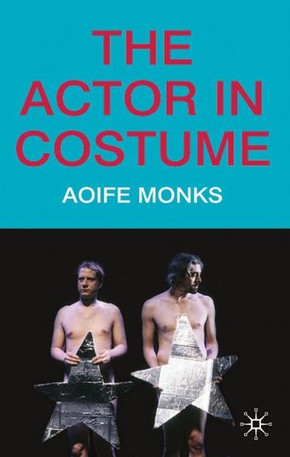V&A Online Journal
Issue No. 3 Spring 2011
ISSN 2043-667X
Review: The Actor in Costume by Aoife Monks
Curator of Modern & Contemporary Performance, V&A
Published by Palgrave Macmillan 2010, pp.176
Hardback ISBN 9780230216990 £50
Paperback ISBN 9780230217003 £16.99
Such is the paucity of writing on stage costume that Costume in the Theatre (1964) written by James Laver, a former Keeper of Prints and Drawings at the V&A, is still one of a handful of books that are regularly recommended to researchers.
The Actor in Costume is, therefore, a welcome addition to a small field: a concise and considered meditation on the interrelationship of performer, costume and audience in the making of a theatrical experience. Where existing works tend to position either the costume or the actor in a supporting role to the other’s genius, this book suggests that ‘costume is a body that can be taken off’ – a melding of actor and outfit for a specific performance in which the role of the audience is to collaborate in the making of meaning as well as appreciate the performance.
As a theatre scholar, Monks is interested in unpicking the way in which costume is glossed over, seen through or fetishised in theatre scholarship and illustrates the various points in these relationships by focussing on moments at which the actor and costume assume a particular force, for example, onstage nudity or cross-dressing. She leads her readers through the book from the backstage experience of the dressing-room through the performance and into the museum/costume store using examples from painting, photography and literature en-route. Her case-studies are well-chosen and demonstrate a range of theatrical events from nineteenth century black-faced minstrels to the Wooster Group’s re-reading of the tradition, moving from Stanislavski and Modernist theatre through to Forced Entertainment and National Theatre of Scotland.
Each of these case studies opens up a new field of enquiry and promotes the urge to further unpick and unpack the ideas and issues they raise, for example, the relationship between stage costume and fashion theory and between stage costume and textile and clothing production. The fundamental questions about the role of the audience in recognising and therefore discursively producing the costumed performer are predicated on the audience’s knowledge of these other areas. The Actor in Costume encourages us – theatre-goers, designers, performance scholars – to question our behaviour when watching actors in costume. It also reminds us that a theatre audience is doing many things during a show: admiring the performances, performers, decorative effects and sometimes switching from the theatrical frame back into the real world, for example thinking ‘I bet that’s uncomfortable’ or ‘I’d like some cushions in that fabric’. But there are other voices that need to be engaged in the discussion about actors and costume that this volume cannot be expected to encompass. Inevitably, in repositioning the actor in costume in the centre of the study, rather than considering the actor alone, the role of the costume designer, maker and wardrobe supervisor in creating a character are once again occluded. Monks’s suggestions about the way in which audiences meld costume and performer go a long way to explaining why the other collaborators in the costuming process go unconsidered: there is still a level at which stage costumes seem to be considered clothes, while a chair on stage is never seen as just a chair, but is routinely understood as part of the scenography. What we need now in the field of costume and performance studies is a book that combines Monks’s theoretical rigour and imaginative insights with technical expertise, a book that does for performance costume what Christopher Baugh’s Theatre, Performance and Technology did for scenography, namely providing a starting point from which makers, designers, performance theorists and historians can work towards a more encompassing history and theory of costume for performance.
Issue No. 3 Spring 2011
- Editorial
- Promoting corporate environmental sustainability in the Victorian era: The Bethnal Green Museum permanent waste exhibit (1875-1928)
- ‘Nothing of intrinsic value’: The scientific collections at the Bethnal Green Museum
- Shedding light on the digital dark age
- John Thomas and his ‘wonderful facility of invention’: Revisiting a neglected sculptor
- Dialogues between past and present: Historic garments as source material for contemporary fashion design
- Kütahya ceramics and international Armenian trade networks
- X-radiography as a tool to examine the making and remaking of historic quilts
- A patchwork panel ‘shown at the Great Exhibition’
- An adorned print: Print culture, female leisure and the dissemination of fashion in France and England, around 1660-1779
- Seating and sitting in the V&A: An observational study
- Review: The Actor in Costume by Aoife Monks
- Review: Not quite Vegemite: An architectural resistance to the icon
- How to submit a proposal to the V&A Online Journal
